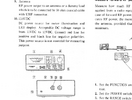I see I arrived to the party late.
But if possible with those potentiometers - just try to remove them from the main front panel - that bulkhead and plastic, but you don't nee to unsolder any wires, just reheat the rotating part of the shaft to free up the lube inside to also provide some action to reduce some of the "scratchy-ness" or noise you get when you rotate those pots.
Its' the composition - as you found out with the Mic gain pot, that develops a "memory" where it sits at and will develop - like any thing else in life, a flat spot there that makes the pot seem worthless. A simple gentle cleaning and when stored, you rotate the pots to a stop (usually fully counterclockwise) to remove the dimple and reseat the wipers' notch that rubs across the composition to a position that is more the metal tab connection to the substrate and then when you move that knob the wiper arm then won't develop that dimple.
- To help, the times I worked on Galaxy radios, those that had "bad pots" usually was from shipping issues - or worse, a face plant - where the knobs bore the weight of impact or thrust action because the shipper packaged the radio in such a way that the knobs - although padded to keep the radio from shaking in the box - did not and is not designed to handle a lot of weight or made to bear the brunt of getting thrown in a bin only to be pressed down further into it as the boxes of other stuff piled up on top of it. The knobs may survive - but the composition it uses to make it variable (that analog world we live in) can't survive the stress.
That is just for starters - but these radios - as your are learning - have many components that are not obtainable anymore - you can buy and use from other sources but they don't have the characteristics the OE once had.
So to tune this up, seems the you may have been in too much of a hurry to try to get it working again. The amazing thing about this here and goes to remind the rest of us, you stuck with it - because it means something to you. You got it working. But now - you have it back to specs and you just want some guidance - so if it were my equipment - being conservative with power levels and voltage supplies - work better to keep more of this board stable as you work the kinks out of that chassis that developed these issues during storage.
Wish you the best of luck on this...
And to the rest of the Clan...



